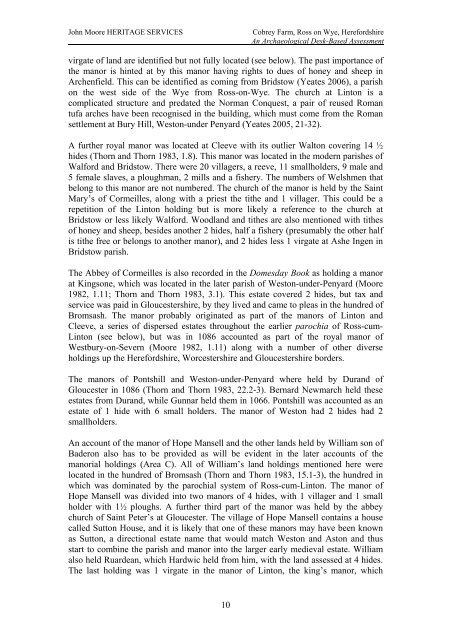JOHN MOOREHERITAGE SERVICES - Archaeology Data Service
JOHN MOOREHERITAGE SERVICES - Archaeology Data Service
JOHN MOOREHERITAGE SERVICES - Archaeology Data Service
Create successful ePaper yourself
Turn your PDF publications into a flip-book with our unique Google optimized e-Paper software.
John Moore HERITAGE <strong>SERVICES</strong> Cobrey Farm, Ross on Wye, Herefordshire<br />
An Archaeological Desk-Based Assessment<br />
virgate of land are identified but not fully located (see below). The past importance of<br />
the manor is hinted at by this manor having rights to dues of honey and sheep in<br />
Archenfield. This can be identified as coming from Bridstow (Yeates 2006), a parish<br />
on the west side of the Wye from Ross-on-Wye. The church at Linton is a<br />
complicated structure and predated the Norman Conquest, a pair of reused Roman<br />
tufa arches have been recognised in the building, which must come from the Roman<br />
settlement at Bury Hill, Weston-under Penyard (Yeates 2005, 21-32).<br />
A further royal manor was located at Cleeve with its outlier Walton covering 14 ½<br />
hides (Thorn and Thorn 1983, 1.8). This manor was located in the modern parishes of<br />
Walford and Bridstow. There were 20 villagers, a reeve, 11 smallholders, 9 male and<br />
5 female slaves, a ploughman, 2 mills and a fishery. The numbers of Welshmen that<br />
belong to this manor are not numbered. The church of the manor is held by the Saint<br />
Mary’s of Cormeilles, along with a priest the tithe and 1 villager. This could be a<br />
repetition of the Linton holding but is more likely a reference to the church at<br />
Bridstow or less likely Walford. Woodland and tithes are also mentioned with tithes<br />
of honey and sheep, besides another 2 hides, half a fishery (presumably the other half<br />
is tithe free or belongs to another manor), and 2 hides less 1 virgate at Ashe Ingen in<br />
Bridstow parish.<br />
The Abbey of Cormeilles is also recorded in the Domesday Book as holding a manor<br />
at Kingsone, which was located in the later parish of Weston-under-Penyard (Moore<br />
1982, 1.11; Thorn and Thorn 1983, 3.1). This estate covered 2 hides, but tax and<br />
service was paid in Gloucestershire, by they lived and came to pleas in the hundred of<br />
Bromsash. The manor probably originated as part of the manors of Linton and<br />
Cleeve, a series of dispersed estates throughout the earlier parochia of Ross-cum-<br />
Linton (see below), but was in 1086 accounted as part of the royal manor of<br />
Westbury-on-Severn (Moore 1982, 1.11) along with a number of other diverse<br />
holdings up the Herefordshire, Worcestershire and Gloucestershire borders.<br />
The manors of Pontshill and Weston-under-Penyard where held by Durand of<br />
Gloucester in 1086 (Thorn and Thorn 1983, 22.2-3). Bernard Newmarch held these<br />
estates from Durand, while Gunnar held them in 1066. Pontshill was accounted as an<br />
estate of 1 hide with 6 small holders. The manor of Weston had 2 hides had 2<br />
smallholders.<br />
An account of the manor of Hope Mansell and the other lands held by William son of<br />
Baderon also has to be provided as will be evident in the later accounts of the<br />
manorial holdings (Area C). All of William’s land holdings mentioned here were<br />
located in the hundred of Bromsash (Thorn and Thorn 1983, 15.1-3), the hundred in<br />
which was dominated by the parochial system of Ross-cum-Linton. The manor of<br />
Hope Mansell was divided into two manors of 4 hides, with 1 villager and 1 small<br />
holder with 1½ ploughs. A further third part of the manor was held by the abbey<br />
church of Saint Peter’s at Gloucester. The village of Hope Mansell contains a house<br />
called Sutton House, and it is likely that one of these manors may have been known<br />
as Sutton, a directional estate name that would match Weston and Aston and thus<br />
start to combine the parish and manor into the larger early medieval estate. William<br />
also held Ruardean, which Hardwic held from him, with the land assessed at 4 hides.<br />
The last holding was 1 virgate in the manor of Linton, the king’s manor, which<br />
10

















